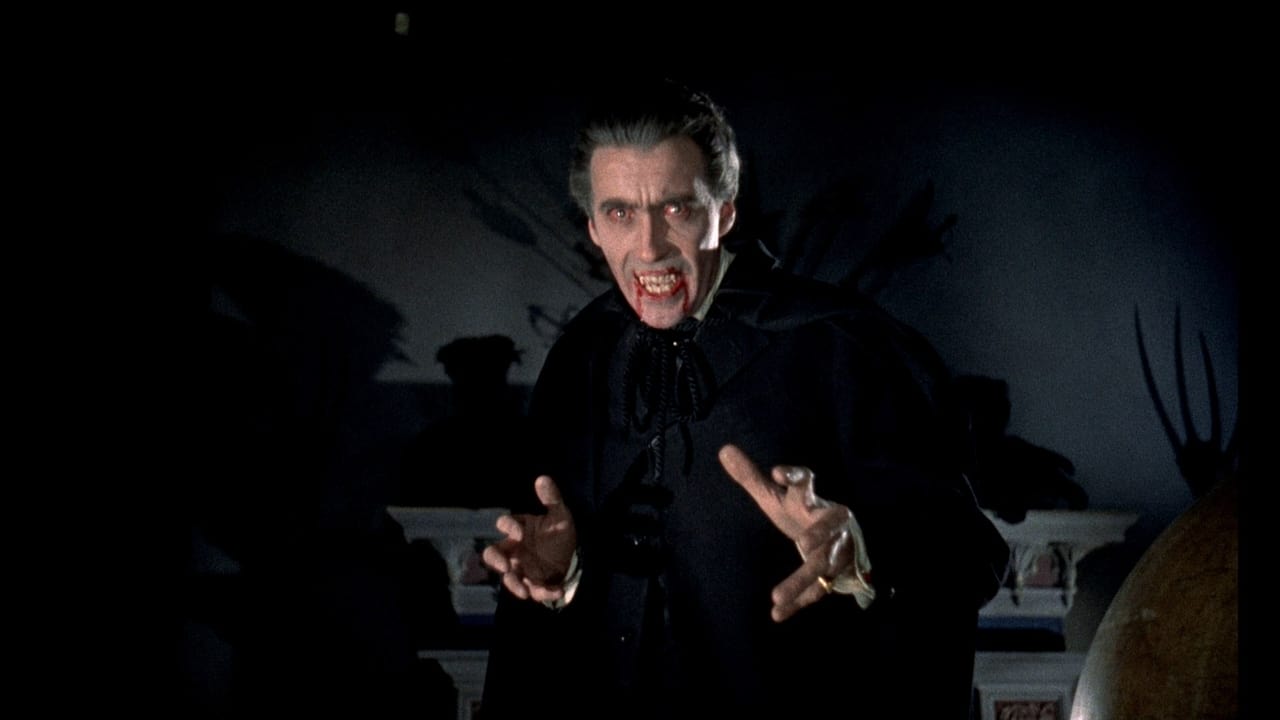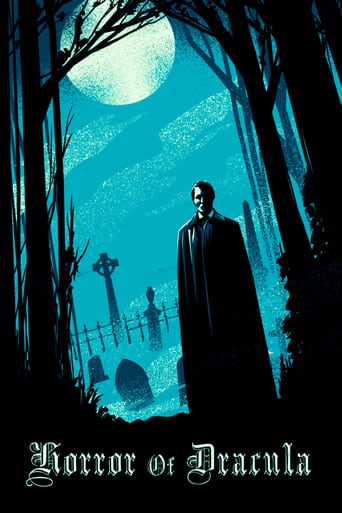

The first color-filmed Dracula (minus the tinting/toning of "Nosferatu" (1922) and a brief shot from the contemporary "The Return of Dracula" (1958)), we finally got to see the technicolor red blood in a cinematic treatment of Bram Stoker's novel—actually, this is the first instance of much if any blood at all in a Dracula movie. Another indication of the more-relaxed censorship by 1958, Hammer's "Dracula" is considerably more sexualized. Beyond introducing the familiar story to the splatter subgenre of its day, however, it's a relatively routine, if not bare-bones, adaptation story-wise, although, consequently, the plotting is punchier than most other Dracula movies.It wastes little time in jumping into the action, as Jonathan Harker is changed into a librarian imposter (yeah, I don't know why – an allusion to the film's source, perhaps) and undercover vampire hunter. The part of skeptic is played by the expanded role given to Arthur Holmwood, who's largely the Watson figure here to Van Helsing's Sherlock Holmes. Viewing this film, it's not surprising in the least that Peter Cushing, who plays Van Helsing, would play Holmes the very next year in "The Hound of the Baskervilles," nor is it surprising that he'd later play the Doctor, who also gets to show off his brilliance to stupid companions, in a couple "Doctor Who" movies. Meanwhile, Michael Gough, as Arthur, later turned to serve another batman in the 1989-1997 comic-book tetralogy. There was always an element of Holmes/Watson to "Dracula," demonstrating the connections between the horror and mystery genres, but finally having Englishmen play the parts surely stresses the similarities.Mina and Lucy, instead of switching roles this time, as they have in other adaptations, trade lovers, with Jonathan becoming Lucy's beloved and Mina marrying Arthur. Incestuously, Lucy also becomes the sister of Arthur, her former fiancé from the novel. As with most misogynist movie revisions of Stoker's tale, the two leading ladies are turned into lustful damsels-in-distress while the men play heroes. Additionally, Dr. Seward's role is reduced, and Renfield and the Texas suitor are eliminated (a Renfield type, however, appears in the third film of the series, "Dracula: Prince of Darkness" (1966)). The three female vampires from Castle Dracula are reduced to one, but this is compensated for by her displaying ample cleavage.Christopher Lee's Dracula is a relatively mute rendition; the titular role is reduced here to a supporting character to the crime- solving duo of Van Helsing and Arthur. But, with the aid of dramatic reveals involving thundering music, cutaways and close-up entrances, Lee does make an impact. His Dracula is basically just a monster, sporting fangs, blood-shot contacts and a blood-stained mouth, yet still mostly in the suave vampire tradition of Bela Lugosi. That's fine; it's appropriate for the action-packed pacing and splatter-type horror of this "Dracula." And having an ugly Count, as in the novel, would've distracted from the sexual acts of his book-connoisseur, country gent preying on the townsfolk's women. Oddly, there's also more crosses in this version, including a makeshift one (a gimmick reused ad nauseam in the sequels), which Van Helsing employs in the special-effects-laden climax, to trap the vampire between him and a "Nosferatu"-style sunbaked fate. A bit limp for a red-blooded Dracula.(Mirror Note: No mirror shots. The only mirror isn't used for a through-the-mirror shot; it's merely for Jonathan to examine his bite mark.)
... View MoreThis is really not a very good movie.It is nowhere near the quality of the 1931 film and at times it is so confused that it approaches Ed Wood levels; and Wood's characters were seldom as lacking in energy and intention as the characters here.The one thing I will give it credit for is the frank sexual aspect that it gives to the vampiric relationship between Christopher Lee's Dracula and his female victims, and I have given it an extra star or two on that account. Although that makes the movie pretty much a celebration of rape fantasies: the tall virile man dominates his prey! The woman is ashamed and fearful, but she thinks only of his coming to her bed! etc.In order to claim that this movie is of higher quality than I've indicated, some process other than normal evaluation must be in play. Perhaps one feels that because this movie played an important part in the history of the Hammer studio and its Dracula franchise, it deserves to be uprated just because of its historical significance? I don't think that's how it works.The story is nowhere near as well thought out as the Abbott and Costello monster movies always were. I will rant about geography for a few sentences just to make my point. The Stoker novel begins in Transylvania; the Count voyages to London; then it ends up in Transylvania again. This is a lot of unnecessary traveling, so the 1931 movie (based on an earlier play) starts in Transylvania and then just has all of the conflict take place in London.The Hammer film decides to save on travel even more, by putting all the action into a sort of tiny space-warped Europe-themed park, at one end of which is Klausenburg (the capital of Transylvania) and at the other of which is Karlstadt, a German city populated by English people, which is 800 miles from Transylvania on the map of Europe but only about 20 miles away in this movie, a brief carriage ride away. You may think this is a picky point, but my real point is that any middle-school student would come up with a geographical approach that made more sense. The middle-school screenwriter would also have more of a sense of the do's and don'ts of vampire-hunting: for example, when you have only a few minutes before sunset to go and kill vampires, don't waste time writing about it in your miserable journal! (In fact it seems that Harker could have just dispatched Dracula in the first minute of this movie if he had had any gumption.)The middle-school screenwriter might think that the male characters should devote more attention to actually preventing the female ones from being killed and converted to vampires, and to care more if they fail in it. But I can't blame that entirely on the screenplay; the blame for the characters' languid attitude has to be shared by the actors and director as well.Much of the vampire-chasing action involves Dracula running out of rooms in order to come back in and make an entrance, taking no thought for the time of day or presence of windows (why does he even have windows in his castle, why hasn't he boarded them up in 600 years). Meanwhile his opponents act as if crucifixes and garlic cost their weight in diamonds, and decline to deploy them as they should. I could go on in this regard, but it isn't worth it.
... View MoreOne can get caught up in only acceptance of the oeuvre of such things as Dracula and Frankenstein. One has to admit at some point that the cinematic presentations of the 1930's grossly misrepresented the original works of literature. Did that damn them in any way? Of course not. So sometimes we criticize a more contemporary effort because of its roots. In this wonderful episode, Christopher Lee is an outstanding Dracula. This is kind of an after-the-story story where the principle characters move on. Dracula is still a danger to the world, and Van Helsing and the others are trying to put a stop to his reign. Jonathan Harker, Mina, Lucy, and the rest are still involved in some way. The acting is great. The scenes of horror are startling and grotesque. The sets are really quite remarkable. One of the better adaptations of the Dracula canon.
... View MoreSomeone here recorded it, so I thought, 'what the heck'. This was a big surprise, as it was good! Ordinarily I would have passed on it, having seen other films like it which were junk movies, pure and simple. But the main role went to Peter Cushing playing Helsing, the vampire slayer (I borrowed that from a current popular entity), and I can report that neither he nor Christopher Lee overacted or hammed it up as they did in other over-the-top horror films. The story moved along, the color was natural and the plot was (almost) plausible, never descending into vaudeville. Good supporting acting and a thoroughly refreshing dip into the horror genre make this one worth recommending.
... View More